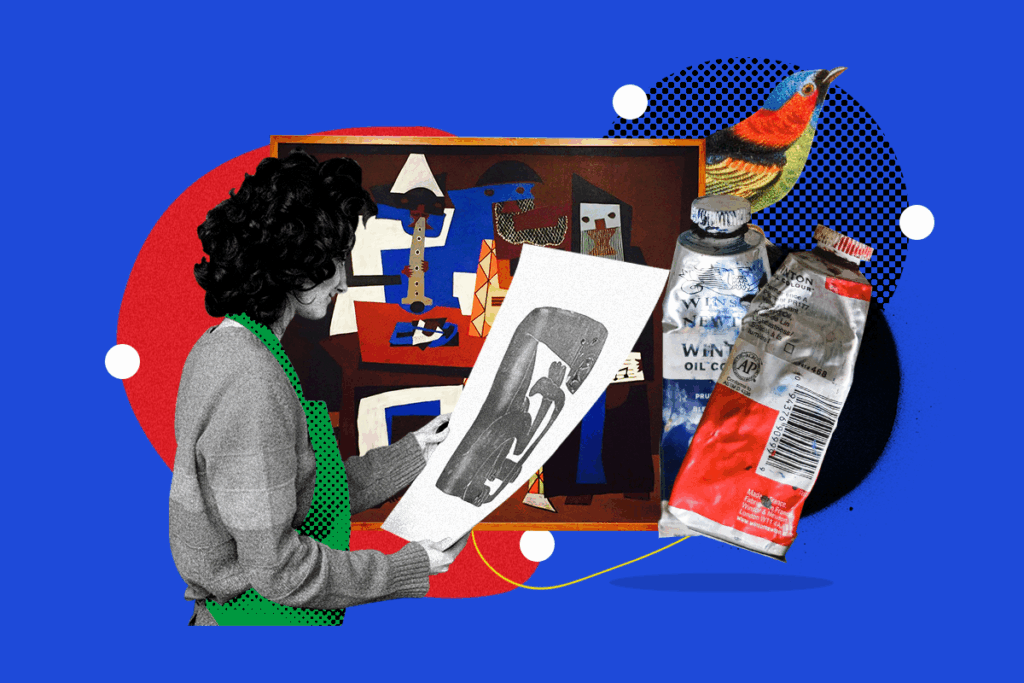How to Invest In Art (You Can Afford)
What if you could own a piece of a Picasso? Or buy a Basquiat on a budget? From finding up-and-coming contemporary artists to buying shares of some of the greatest masterpieces of all time, here’s how to become an art investor on a budget.

In his song “The Story of O.J.,” Jay-Z raps about achieving financial freedom and building wealth not through record sales, but by finding the right art to invest in. The hip-hop artist turned art collector brags:
“I bought some artwork for one million
Two years later, that shit worth two million
Few years later, that shit worth eight million”
For reference, if Jay-Z had simply put that $1,000,000 in the stock market for five years and gotten the average 10% return, it’d only be worth $1.645 million instead of $8 million. Easier than finding art to invest in, yes, but nowhere near as much money-making potential.
Herein lies the lure of art collecting: discover the next Warhol, and you might as well have won the lottery.
Unfortunately, finding good art to invest in isn’t easy, and the initial cost to invest can be steep. (Fun fact: the buyer of Banksy’s famous “Girl With Balloons” print paid $1.4 million for it—and that was after a secret shredder hidden in the print’s frame unexpectedly tore the art piece to shreds).
So how do you find art to invest in if you don’t have seven figures to drop? From finding up-and-coming contemporary artists to buying shares of some of the greatest masterpieces of all time, here’s how to become an art investor on a budget.
How investing in art works
Like any other investment, when you invest in art, you’re banking on its value going up over time. With art, this happens when demand for the artwork increases faster than supply.
When Jay-Z shouts out his favorite artists in his songs with lyrics like “I just want a Picasso, in my casa” and “Yellow Basquiat in my kitchen corner / Go ahead lean on that shit Blue / You own it,” he’s not just rhyming Picasso with casa because it sounds good. He’s generating buzz, which stimulates demand—and will in turn increase the value of his own investments.
On top of increasing demand, a limited supply will make your art investment even more valuable. A one-of-a-kind, original painting will likely be worth more than a print, and a limited edition print will likely be worth more than a mass-produced print.
If you get serious about collecting valuable art, you’ll probably want to get it insured. The cost of insuring artwork is usually 1% to 2% of the value of the work of art. That yellow Basquiat Jay-Z refers to in his song? Well, Basquiat’s Untitled (Yellow Tar and Feathers) sold for $23 million in 2014, which means it’d cost about $230,000 to $460,000 per year to insure. Of course, most people won’t be buying multi-million dollar art…at least not yet.
You can also get your art appraised by an appraiser to find out how much it’s worth, which costs anywhere from $25 to $300 an hour or more. Once it’s time to cash out, you can sell your art online, through an auction house, or to an art gallery.
3 Ways to find affordable art to invest in
While it’s true that investing in art usually requires a big budget, there are some loopholes. Here are a few ways to find art to invest in, even if you only have a few hundred dollars to spare.
1. Low cost, high risk: Up-and-coming artists
If you’re looking for cheap art to invest in, scouring the art market for up-and-coming artists is one of the most affordable, but also riskiest, ways to do it. Finding artists who will make it big is a bit like trying to find your 5 foot 2 friend at Coachella: you’re scanning a sea of flower crowns and feathers, halfway blinded by all the glitter, just trying to spot that one wide-brimmed hat she wore that looks like all the others.
Get an art world education: You could hop on the ferris wheel for a bird’s eye view of the crowd. When it comes to art investing, this entails arming yourself with a solid knowledge of art history and the contemporary art world. Buy some art books, attend museum shows, get a sense of which contemporary artists are gaining momentum, and become a regular in your local gallery scene.
Even if you do spot your friend off in the distance, though, she could dart off to a different stage just as quickly. Similarly, you’ll never be able to predict exactly where the art world will go—especially when it comes to younger, up-and-coming artists. You should always invest in art you love, that way if it doesn’t gain value, at least you own a piece of art you can enjoy.
Invest in Black artists: Unfortunately, the work of Black artists is still extremely undervalued in the art world. This is also true for artists of color in general and women artists. Art Review has been dropping a Power 100 list of the most influential contemporary artists since 2000, and it wasn’t until 2017 that the first Black artist finally made the top 10. On a list of top 100 most collectible living artists created by artnet in 2015, Yayoi Kusama was the only woman to make an appearance.
This is an opportunity for you to get in on an undervalued asset with serious potential to skyrocket while also supporting artists who deserve more recognition. Prolific art collector and ex-investment banker Freda Isingoma created KIISA, an investment firm dedicated to modern and contemporary African and diaspora art, for this reason.
2. High cost, low risk: Blue-chip artists
If you have a little more money to play with, blue-chip artists (named after blue-chip stocks) are well-established artists whose artworks have provided consistent returns at auction sales over the years. They include household names like Picasso, Monet, Matisse, Warhol, and Modigliani as well as living artists and contemporary favorites like Damien Hirst, Jean-Michel Basquiat, Takashi Murakami, and Yayoi Kusama.
Think outside the canvas: While an original blue-chip painting is out of budget for most art investing beginners, (they can sell for hundreds of thousands, if not millions), there are other ways to collect art from these popular and reliable masters. Works on paper, such as drawings and fine-art prints, tend to go for much more affordable prices—sometimes even in the low hundreds. Photographs and sculptural objects can also be reasonably priced for entry-level collectors. In 2018, esteemed auction house Christie’s put up dozens of these types of works by major blue-chip artists for sale online with estimates as low as $325.
To familiarize yourself with blue-chip artists, take a look at the Artprice100 index. This is a list of the 100 most important artists currently on the art market. It’s a theoretical rather than a real index (you can’t buy shares in it), but it does track the value of artwork by these 100 artists. Since 2000, it’s gone up 405%—its annual price appreciation rate of 8.9% is well above the S&P 500’s average annual return of 3.4% over the same time period.
You can track the work of any living artists whose work you enjoy by subscribing to their newsletters to be notified when they release prints and do gallery shows. You can also follow auction houses and art database websites to be notified of art sales.
3. Low cost, low risk: Partial ownership of master works
What if you could own multi-million dollar artwork without actually spending millions? Imagine owning a small piece of a Picasso—say, that eyeball up in the top right corner—for a few thousand dollars.
Buy shares of Banksy: This is basically what Masterworks lets you do. Similar to buying shares in a company on the stock market, Masterworks lets you partially invest in artwork by some of the best selling artists of all time. They’re the first company to blow the lid wide open on art investing and make ownership of great masterpieces accessible to anyone with $1,000.
Not only is this option more financially accessible; it’s also easier to start for people who aren’t art experts. Masterworks has a team of art researchers who identify blue-chip artists who are gaining momentum and providing consistent returns, and then they purchase that artist’s best works. As a Masterworks member, you can then buy and sell shares of those artworks on their secondary market. There are no transaction fees, just a 1.5% annual management fee (paid in the form of equity—or the portion of Masterworks’ assets that you own—so you don’t have to pay it out-of-pocket), and you can get started with as little as $1,000.
Tips for buying art
- You can buy art through galleries, art dealers, or directly through the artist. To get even thriftier (and riskier), you can also frequent second-hand stores and estate sales.
- When you find a piece of art you think has potential, figure out who the artist is (look for the artist’s signature if you’re not buying through an official channel).
- Look up the artist on Artsy and Artnet. Here you can learn more about the artist and browse prices of any works currently being sold.
- Identify the piece you’ve found by figuring out its title and when it was made. Often, you can find a title, edition number, and sometimes release date on the back of a fine-art print by the signature.
- Not all works of art by the same artist are created equally. Research that particular piece to find out if it’s considered a quality piece of work. Both auction houses and art databases like Artsy have art specialists who will help you with your questions free of charge, so take advantage of that.
- Make sure it’s authentic. If you’re purchasing from the artist or a reputable gallery or dealer, you should get any paperwork that certifies the piece is authentic and hold onto your bill of sale. If not, you can take the piece to an authenticator (ask around at museums and university art departments) to get a certificate of authenticity.
Is art a good investment?
While lesser known artists are always a gamble, blue-chip art does have a good track record of outperforming the stock market.
From 2000 to 2018, blue-chip art managed to outperform the S&P 500 by 180%. In October 2019, Masterworks purchased Banksy’s “Mona Lisa” for $1,039,000. One year later, they sold the painting for $1,500,000. That’s a 32% annualized return—double what the stock market offered over the same period of time, and triple the stock market’s average annual return of 10%.
If you’d gotten in on that Banksy with $10,000 worth of shares in “Mona Lisa,” you’d be at about $13,713 after a single year. Hold onto those shares for a decade, and you’d be sitting on over $235,000.
That being said, the art world can be notoriously fickle. Even the most seasoned art collectors can never be sure what the value of any given painting will look like ten or 20 years down the line. This form of investing plays by its own rules, and it’s also not very liquid.
For that reason, art should only take up a small percentage of your portfolio. Make sure you have your core investments in place before you start seriously branching into the world of art collecting. Once you do, though, finding art to invest in can be a thrilling game to play, particularly for those with an appreciation for both beauty and cash.
